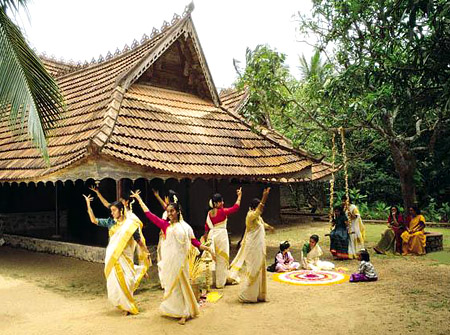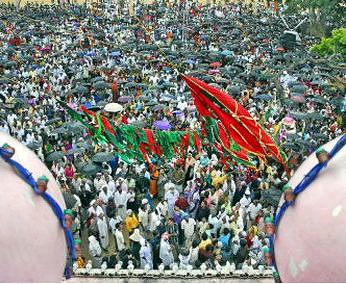Festivals hold a central place in the life of a Malayi. In a span of a year a Malayi celebrates several festivals. As one year passes by more and more number of festivals gets added to the life of a Malayi. Like all the other districts of Kerala Tiruvananthapuram celebrates a number of festivals. Some of the festivals that are celebrated in the region are Onam, Attukal Pongala Festival, Chandanakudam Mahostsavam, and the Vetta and Arattu. In addition to these a number flavour and food festivals are celebrated in the district throughout the year.
Onam
 Onam, a grand festival of Kerala as well as Tiruvananthapuram are celebrated in the months of August and September. The festival is celebrated with a lot of pomp and show along with the Tourism Festival organised by the Tourism Department of Kerala. It is a week long festival. During this time streets are decorated with multi-coloured lights and the pavements are encroached upon by street vendors. Several traditional as well as cultural programmes are staged throughout the district during the festival of Onam. The week long festival ends with a pageant. Some of the major attractions of the ceremony are different traditional folk arts forms, martial arts like kalaripayattu, Thayambaka, Pandi melam, singari melam, drum beat, spectacle of different floats, and the elephant procession.
Onam, a grand festival of Kerala as well as Tiruvananthapuram are celebrated in the months of August and September. The festival is celebrated with a lot of pomp and show along with the Tourism Festival organised by the Tourism Department of Kerala. It is a week long festival. During this time streets are decorated with multi-coloured lights and the pavements are encroached upon by street vendors. Several traditional as well as cultural programmes are staged throughout the district during the festival of Onam. The week long festival ends with a pageant. Some of the major attractions of the ceremony are different traditional folk arts forms, martial arts like kalaripayattu, Thayambaka, Pandi melam, singari melam, drum beat, spectacle of different floats, and the elephant procession.
Attukal Pongala Festival
Attukal Pongala festival is a famous temple festival in Thiruvananthapuram which attracts thousands of devotees. The presiding deity of the temple is Sree Bhagavathi`. The temple is known as `The Sabarimala of Women`. Attukal Pongal Festival is a ten day celebration. During the festival the flow of devotees in the temple premises is uncontrollable. On the ninth day of the festival women from various different parts of the state and country gather in the temple to offer Pongal to the goddess Bhagvati. The pongal starts in the early morning and ends in the evening when the hundred of priests come out of the temple with` the sword of the goddess` and walk to the hearth of pongal, made by each devotees for pouring holy water and showering flowers over .At this sacred moment the petals of flowers are dropped from the helicopter in the temple premises.
Chandanakudam Mahostsavam
 The death anniversary of a pious Muslim woman named Beema Beevi is celebrated as chandanakudam mahostsavam in beemapalli. The festival has ten day duration. Every year the festival is celebrated with a lot of pomp and show. Rather it can be said this occasion is celebrated in a very grand manner. Devotees from all over the Tiruvananthapuram come to the place to offer coins in an earthen pot decorated with flowers and incense sticks. The body of the pots are tarnished with sandalwood paste and the mouths are covered with a white cloth and garland. Generally three incense sticks are pressed on the white cloth and the pots are known by the name chandanakudam. The festival commences on the jamadul of the Hijra year with flag hoisting. On the tenth day the flag is gradually lowered. It is a major festival in Beemapalli which is a shrine dedicated to the memory of Beema Beevi. This shrine is situated in muttathura village which is five kilometres south-west of Thiruvananthapuram.
The death anniversary of a pious Muslim woman named Beema Beevi is celebrated as chandanakudam mahostsavam in beemapalli. The festival has ten day duration. Every year the festival is celebrated with a lot of pomp and show. Rather it can be said this occasion is celebrated in a very grand manner. Devotees from all over the Tiruvananthapuram come to the place to offer coins in an earthen pot decorated with flowers and incense sticks. The body of the pots are tarnished with sandalwood paste and the mouths are covered with a white cloth and garland. Generally three incense sticks are pressed on the white cloth and the pots are known by the name chandanakudam. The festival commences on the jamadul of the Hijra year with flag hoisting. On the tenth day the flag is gradually lowered. It is a major festival in Beemapalli which is a shrine dedicated to the memory of Beema Beevi. This shrine is situated in muttathura village which is five kilometres south-west of Thiruvananthapuram.
Vetta and Arattu
The word `Vetta` means `the hunting down the demon of evil in a forest by Lord Vishnu`. The Vetta and Arattu processions are celebrated twice a year and it starts from Sere Padmnabha Swami Temple. The procession ends in the courtyard of sundra vilasm palace.
Food Festival
In the period from April 5th to April 11th every year an Indian food festival takes place in Tiruvananthapuram. The festivals take place in Kanakakkunnu palace. All the top hotels of the Kerala participate in the festival. Variety of food including Chinese, Continental, South Indian and North Indian are offered during this platform and it is one of the best platforms to taste good food.



















